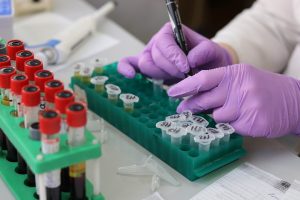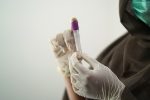
The American Red Cross is one of the most notable organizations when blood drawing is in question, but they also provide training programs for future phlebotomists.
The Red Cross is full of volunteers, but there are some employees who receive a salary.
If you are interested in getting phlebotomy training with the Red Cross, you should know that this organization has locations throughout the country, so you can definitely find one that will be close to where you live.
Not only will you learn the skills of venipuncture, but you will also learn how to work with different kinds of patients.
Even though you get the training at the American Red Cross training program, it does not mean that you are obliged to work or volunteer with them.
However, we suggest volunteering as a way to gain valuable experience.
That way you will improve your resume which will be of great help to find a trainee phlebotomy job.
We will speak about all the things you can expect from the Red Cross Phlebotomy training program.
Page Navigation
- Phlebotomy Training with the Red Cross
- What Does Training Cost?
- What Does a Training Course Include?
- Does the Red Cross Offer Safety Training?
- Should I Take a Certification Exam?
- Who Can Take Phlebotomy Training with the Red Cross?
- Where to Find a Job after Phlebotomy Training
- What Skills Should a Phlebotomist Have?
- What Are Other Volunteer Opportunities for Phlebotomists?
- Are There Other Programs Available?
- Can You Advance Your Career?
- What Are the Benefits of Working for the Red Cross?
- Is the Red Cross a Good Place to Get Phlebotomy Training?
Phlebotomy Training with the Red Cross
Being that there are no specific requirements for entering phlebotomy training courses, the same applies to Phlebotomy Training with the Red Cross.
Entrance requirements are to be at least 18 and have a high school diploma or GED.
Plus, due to the fact that the Red Cross is a highly recognized organization they have some additional requirements that applicants have to meet.
These include the following:
- Turning in standard forms given by the organization
- Completing a background check
- Turning in an application form with a physical form
- Undergo a drug screening
- Pass an entrance exam
- Pass a physical exam that includes a tuberculosis test
- Receive the Hepatitis B vaccine
We would like to mention that other phlebotomy training programs do not have these requirements.
The reason why many people decide to finish the Red Cross phlebotomy training is that if you have that qualification on your resume, you will look more reliable and employers will consider you a better phlebotomist.
Employers are interested in where their future employees got their training.
What Does Training Cost?
The Red Cross phlebotomy training costs $965, but it is prone to changes each year.
The price includes both tuition and fees.
If you choose a phlebotomy training program offered by some other organizations, the price ranges from $700-$1500 and the Red Cross program is in the middle.
It is believed to be the best program for that money, considering the type of education you can get from such a recognized organization.
Plus, the quality of education you will get is great, as they keep their classes small with 8-16 students and you can easily get all the answers that you need right away.
What Does a Training Course Include?
The training program consists of two different parts which involve 80 hours of classroom preparation and 40 hours of lab work/hands-on work.
A classroom setting is taught before having to perform venipuncture.
During the first part of your program, you will be covering the phlebotomy basics and besides learning how to draw blood, you will also be taught the science behind that.
It consists of the following:
- Medical terminology
- Human anatomy
- Systems of the body
- How to collect and process blood
- How to transport blood to clinical labs
- Physiology
After finishing the classroom part of your training, students move to a hands-on approach during which they learn two different types of venipuncture.
These are butterfly venipuncture and syringe venipuncture, and their names refer to the type of needles and equipment used.
Students practice blood drawing from a training arm and everything is done under the supervision of a phlebotomist or teacher.
All this training is necessary so as to make students comfortable with different types of venipuncture, being that not every patient will have a ‘good’ vein on their arm.
It is harder to draw blood from an obese person, so students need to get familiar with different places to draw from and various techniques.
Does the Red Cross Offer Safety Training?
Being that safety training is considered as one of the most critical aspects of phlebotomy training, the Red Cross offers it as well.
Students will learn standard safety procedures put in place by the Center for Disease Control (CDC).
Safety procedures include protecting yourself and your patients and making sure that nothing gets contaminated.
During this training, students will get acquainted with the importance of protective gear like gloves and even goggles.
Safety training also involves proper labeling and transferring of blood samples, being that a phlebotomist is the one who is responsible for samples to be accurately labeled.
Knowing lab safety procedures and following rules is essential and will keep you protected and better organized.
Should I Take a Certification Exam?
After the completion of your training with the Red Cross, you are allowed to take a certification exam through the National Healthcareer Association (NHA).
Even though certification is not required in the majority of the states, you can consider gaining it as it will make you a candidate that will stand out among others and it will be easier for you to find a job.
A higher salary will be given to you than to those phlebotomists without certification.
Becoming certified does not take long, but extra training is required.
With certification included, the whole program lasts a few months.
Who Can Take Phlebotomy Training with the Red Cross?
Any person who meets the requirements can apply for and take phlebotomy training with the American Red Cross.
They tend to emphasize the three types of people who can benefit the most from this kind of phlebotomy training program:
- Individuals who are eager to start a medical career. Candidates for this training know that phlebotomy is an entry-level career. Of course, you can always make it a life-long career if you wish. Hospitals give an advantage to people who received the training at accredited programs.
- Some healthcare professionals also take phlebotomy training. or at least a part of it. Even though they are already in the healthcare field, they want to have more experience or education in venipuncture. The Red Cross offers a condensed 20-hour version of their training program for people who are already medical professionals. The program covers classroom skills and practical skills which are necessary for phlebotomy professionals.
- First responders and rescuers can also take a Red Cross phlebotomy training program. It is offered in a more ‘intense’ format. It is an EKG Technician and Phlebotomy program that includes CPR training.
Where to Find a Job after Phlebotomy Training
As we have already mentioned, a huge demand for phlebotomists exists due to the aging population who needs medical assistance.
More blood tests are needed as they are the easiest way to determine many different illnesses and conditions.
This is a reason why more phlebotomists are needed and the first place that comes to one’s mind for a phlebotomist to work is a hospital.
Hospitals hire phlebotomists to keep up with this huge demand.
However, working at a local hospital is not the only option for a phlebotomist.
Emergency clinics and private practices hire phlebotomists, as well.
Plus, you can find employment in local blood banks or even the Red Cross.
Of course, once you finish your phlebotomy training, you can choose to be your own boss.
You can become a mobile/traveling phlebotomist who will work when and where is needed.
This option is ideal for people who want to have flexibility, and set working hours.
We have to say that this option has its disadvantage.
It depends on you whether you will build up a client base or not.
The better you are at what you do, the less it will take to have enough clients.
The job rate for phlebotomists is expected to grow over 25% and this is the right moment to start your phlebotomy training, as finding a job should not be too hard.
How much you will earn depends a lot on where you work but on average, phlebotomists make about $32,000 per year.
What Skills Should a Phlebotomist Have?
Among phlebotomy-related skills that you will learn throughout the American Red Cross training, you will also be taught the proper personal characteristics that are necessary to become a phlebotomist.
As you probably already know, being a phlebotomist does not mean that you only need to know how to draw blood.
Phlebotomists must possess a set of characteristics so as to be able to perform the job properly and successfully.
Some of the best characteristics for a phlebotomist involve:
- People skills: It is always mentioned first, being that a phlebotomist is in constant communication with a wide variety of patients daily. Those people can be elderly people, children as well as those afraid of this procedure. Of course, there can be patients that are awkward or rude and a phlebotomist will need to be able to understand them and manage to work with them, without losing his/her patience and being compassionate.
- Ability to work as a team player: This is necessary even for a mobile phlebotomist, as he/she will also need to work with other staff members. A phlebotomist who works in hospitals and clinics will definitely be a part of a team and must work well with all the other members.
- Strong attention to detail: A phlebotomist is in charge of correctly labeling blood samples, so he/she need to pay close attention to details, so as not to make a mistake.
- Highly organized: When drawing blood, you put the samples into vials and it is necessary that you keep those vials organized. Phlebotomists must have strong organizational skills and prepare their equipment in advance. Plus, they must clean up their workplace efficiently after each patient.
- Always follows safety procedures: Safety rules are a part of phlebotomy training and they must be followed. That is the only way to keep yourself and your patients safe.
- Ability to stand for several hours at a time: Physical strength is obligatory if you work in a hospital or clinic as phlebotomists there are on their feet for many hours. You can expect to do a lot of walking back and forth to the lab on-site.
What Are Other Volunteer Opportunities for Phlebotomists?
In case you do not have the proper experience, you might not be allowed to work in hospitals.
If this is the case, your option is volunteering at Red Cross blood drives.
So as t gain the needed experience, you can volunteer at many other places and organizations that even depend on the volunteer work of qualified phlebotomists.
You can also volunteer throughout your career, as you will be helping people in need.
Some of the places where volunteer phlebotomists are necessary:
- Nursing homes
- Insurance agencies
- Prisons
- Local blood banks
- Veterans’ hospitals
- Plasma donation centers
- Drug treatment centers
There are instances when hospitals look for phlebotomy volunteers, especially if they are understaffed.
Are There Other Programs Available?
Phlebotomy is just one part of the training offered by the American Red Cross and interested people can take other training programs as a complement to phlebotomy.
Prospective phlebotomists can also enroll in more than one type of training class and increase the number of opportunities for themselves in the healthcare industry.
Some of the other training classes offered through the Red Cross include:
- CPR training
- First aid
- CAN training
- Instructor training
- Water safety
Those who have completed a phlebotomy training program through the Red Cross sometimes decide to become instructors whose job will be to teach life-saving skills.
You can either become a regular instructor or a disaster relief instructor.
These professionals train people during crises or times of need.
Can You Advance Your Career?
Being that phlebotomy is an entry-level position, for many people it is just used as a starting position which will later lead them into different medical careers.
Some of them even decide to move up in the phlebotomy field, by gaining more experience and more training.
This can enable you to get a promotion and choose a phlebotomy specialty, such as a therapeutic phlebotomist.
The more experience you have, the greater are the chances of gaining a supervisory position.
Of course, you can always continue schooling in the medical field.
Many nurses and doctors started out their career as phlebotomy technicians and then continued to train in other areas of healthcare
What Are the Benefits of Working for the Red Cross?
Phlebotomy training through the Red Cross does not oblige you to work for the Red Cross.
This is just a great opportunity that you can take.
The Red Cross phlebotomists will have tasks that differ a lot from tasks at a hospital.
The Red Cross phlebotomists are found wherever it is needed most and if you get a chance of working for this organization, you will get quite an enriching experience.
The organization provides almost half of the nation’s blood supply and joining their team can be of great benefit for you.
I case you have completed their training program, you will be given the advantage of getting hired.
Plus, the Red Cross provides benefits that any employee would be thrilled to have and some of them include:
- Medical insurance (including vision and dental)
- Personal plans and discounts
- Prescriptions
- Paid time off
- Savings plan
- 401k match
- Commuter benefits
- Employee assistant programs
Is the Red Cross a Good Place to Get Phlebotomy Training?
The answer to this question is definitely – yes.
Training for a phlebotomist is available through dozens of different organizations, but, the Red Cross is an organization that an employer can trust thus making you a more attractive candidate for employment.
The reasons for attending the Red Cross phlebotomy training are numerous, and getting hired easily is not the most important one.
When you get the training by a serious organization, you learn the necessary skills of phlebotomy, as well as much more.
You can choose other classes as well, and take the certification exam.
When your education is finished, you can volunteer or work for the organization.
Another advantage is The Red Cross is neither the most expensive, nor the least expensive, so you can save some money if you do not take an expensive college program.
It takes less than a year to complete your training and after finishing it, you can practice blood draws on people by volunteering which is an ideal opportunity to boost your resume.
All in all, the Red Cross is an ideal place to get your phlebotomy education.








